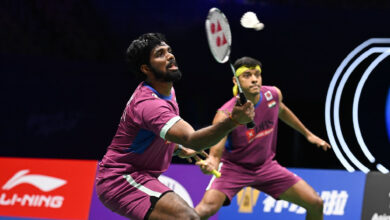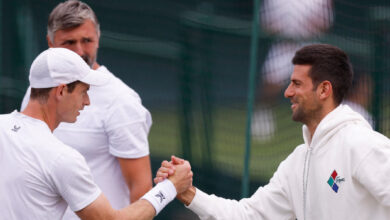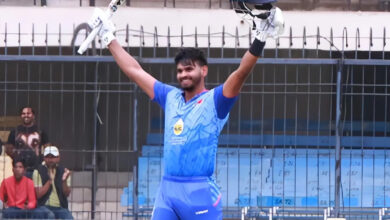Virat Kohli needs his opening batsman to stand up and share the load with him

The 2017 Champions Trophy is six months away. And it will be Virat Kohli’s first true test as India’s ODI skipper. In that light, MS Dhoni’s timely resignation has presented him with a challenge –This summer, Kohli will look to tick off at least a couple pointers looking forward to the 2019 ODI World Cup.
Finding a finisher is top off that list. Sure Dhoni will be playing this summer, and undoubtedly he hopes to somehow stretch it to 2019. Looking at the selection for the ODIs against England, it is expected that Yuvraj Singh too might catch that flight in June. But will he be on the one in 2019? Or will it be one among Manish Pandey, Kedar Jadhav and Hardik Pandya, maybe even someone else?
The lack of an in-form opening combinaton has heaped immense pressure on Kohli, the batsman. AFP
The lack of an in-form opening combination has heaped immense pressure on Kohli, the batsman. AFP
This riddle has vexed the Indian team management for nearly two years now. It began immediately after the 2015 World Cup, a realisation that dawned during the loss in Bangladesh when India were bowled out for 228 and 200 in the first two ODIs. Through successive losses against South Africa (home) and Australia (away), it grew into a real poser as Dhoni struggled to find an optimal batting spot for himself, and couldn’t find an ideal replacement-finisher either.
In turn, this finisher problem has heaped immense pressure on Kohli, the batsman. So much so that the Indian line-up has become increasingly reliant on him, whether setting up the game whilst batting first or chasing a target. Even so, there is another factor contributing to this tricky issue.
India have lacked an in-form, settled opening combination since that ill-fated Bangladesh tour (neglecting second-string tours to Zimbabwe). Sample this – against South Africa in October 2015, Shikhar Dhawan averaged just 25.20 in five ODIs. Despite Rohit Sharma’s fine form in that series (255 runs in five matches), they didn’t manage to put on a 50-run opening stand as India lost 3-2.
Next up, the 4-1 loss in Australia was a weird one. India scored 290-plus in each of the five ODIs, yet lost out to a better bowling attack. But if we dissect their batting statistics from that tour, it perfectly encompasses the problems that are plaguing this line-up at present.
Rohit led the charts with 441 runs in five matches, inclusive of two hundreds and a fifty. Kohli scored two hundreds and two fifties as well. Dhawan started off slow, but finished with two fifties and a hundred in the last three matches. Ajinkya Rahane got two half-centuries in the middle order, and Manish Pandey got his maiden hundred in Sydney, helping India salvage some pride and avoiding a 5-0 whitewash.
There were no other noteworthy contributions from Dhoni (86 runs in five matches), Rishi Dhawan or Gurkeerat Mann as they were shuffled around in the middle order. Then again, look up top – Rohit and Dhawan managed a century stand in only the fifth ODI. For the first three matches, their highest opening partnership was 36 runs.
This is the underlying point. Despite Rohit’s consistent run of form against South Africa and Australia, there haven’t been enough noteworthy contributions from the top to help take some load off Kohli. The common denominator here is in playing according to conditions, and while Rohit-Kohli did their bit alternately, it wasn’t enough to upstage a superior team in their backyard.
It puts the spotlight on Dhawan, who has never been an affirmative opener in the truest sense of the word. Dhoni had given him a long rope, for he provided the slam-bang approach at the top of the order – a poor man’s Virender Sehwag if you please. But the consistency factor never kicked in for the left-hander, unlike the Nawab of Najafgarh.
There were often times – hundreds during 2013 Champions Trophy and 2015 World Cup – that justified his continued selection. Off late though, there is increasing clarity that Dhawan takes too long to adjust to different conditions and opponents, and the team management can perhaps no longer show as much patience.
Herein, Rahane’s ODI record comes into the picture as well. It cannot be denied that he hasn’t enjoyed a consistent run in limited-overs, much like what Rohit has endured in Test cricket. Both have been patchy at best in these respective formats. There is still a difference though.
While the longer format hides Rohit’s frailties, ODI and T20 cricket cannot hide Rahane because certain limitation with regards to tactics kicks in. Beyond Kohli at No 3, Dhoni liked to keep his batting order flexible, thus catering to different match situations (given the recall of Yuvraj, it is apparent that Kohli might opt for the same ploy). A freestyle stroke-maker, Rahane, thus never found his calling in the middle order.
Ever since this realisation dawned on the team management – as late as last year – Rahane has only been in contention for the opening slot. And he hasn’t done himself any favours. Against New Zealand, in Dhawan’s absence due to injury, Rahane scored only 143 runs in five matches, inclusive of a solitary half-century. Even Rohit’s form tapered off, as he managed 123 runs in five innings, with a highest of 70.
India did win against New Zealand, but they were made to sweat. The highest opening partnership between Rohit and Rahane in that series was 49 runs. At the other end, Dhoni scored the only half-century among middle-order batsmen. In between, the onus lay once again on Kohli (358 runs in five matches) as India huffed and puffed across the finish line to win their first meaningful ODI series since 2014.
Consequently, India now have four opening options available for the Champions Trophy as Rohit will surely return to fitness by June. Meanwhile, KL Rahul has stroked his way into the first-choice ODI squad thanks to a brilliant run in 2016.
There is room for only three openers, and thus, the impending three ODI-series against England gains importance for Dhawan and Rahane. Only one of the two will be left standing when the team for the Champions Trophy is picked. For, Kohli will be hoping to sort out this opening mess soonest, so he can concentrate on clearing out the cluttered middle order.







